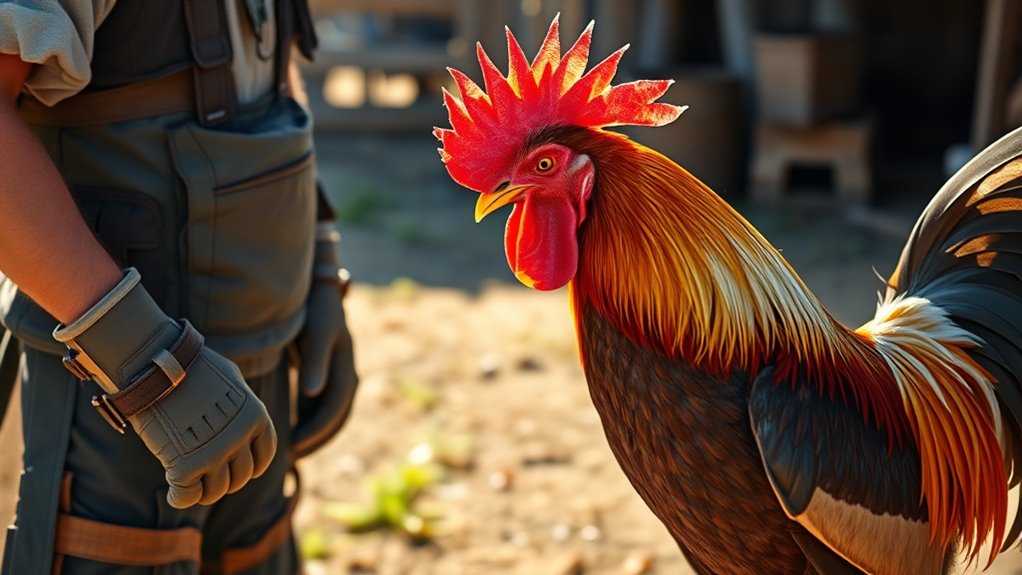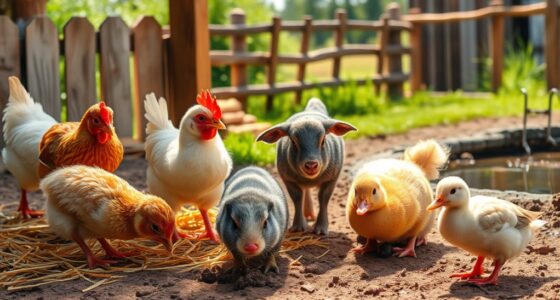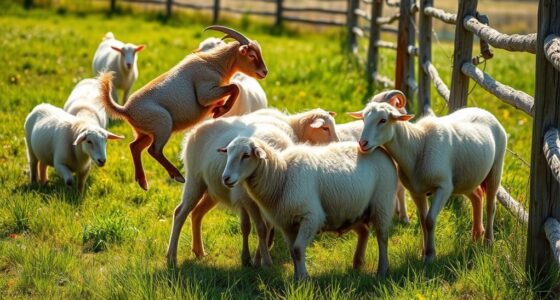Handling aggressive roosters safely means recognizing their signs of aggression, like lowered heads or foot stomping. Establish your dominance using slow, deliberate movements, and wear protective gear to minimize injury risks. Catch them at sundown when they're calm, securing their wings and legs. If aggression persists, consider rehoming after thoughtful management. Understanding these techniques will help you navigate interactions smoothly, and there's much more to explore about managing rooster behavior effectively.
Key Takeaways
- Wear protective clothing, including gloves and long sleeves, to minimize injury risks when handling aggressive roosters.
- Approach roosters slowly and calmly, using slow movements to avoid escalating confrontations.
- Use distractions like food or toys to redirect the rooster's attention during handling.
- Establish dominance by maintaining eye contact and standing your ground when faced with aggression.
- Catch roosters at sundown when they are calm and roosted for easier handling.
Understanding Rooster Aggression
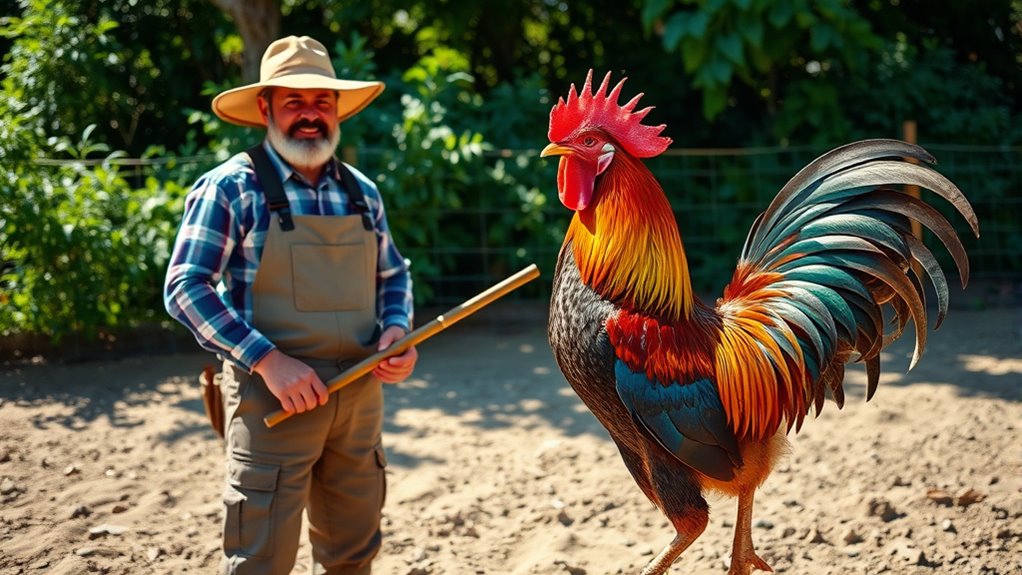
Understanding rooster aggression is essential for anyone who keeps these birds, especially since their protective instincts can lead to aggressive behavior as they mature.
Roosters are natural protectors of the flock, and as they grow, particularly during puberty, their aggression can increase due to hormonal changes.
Recognizing signs of aggression, like lowered heads and foot stomping, helps you gauge their mood.
Recognizing signs of aggression, such as lowered heads and foot stomping, is crucial for assessing a rooster's mood.
Some breeds, such as Cornish Indian Game and Malay, are more prone to aggressive behavior, so choose your roosters wisely.
Keep in mind that they may view humans as threats, leading to confrontations.
Signs of Aggressive Behavior
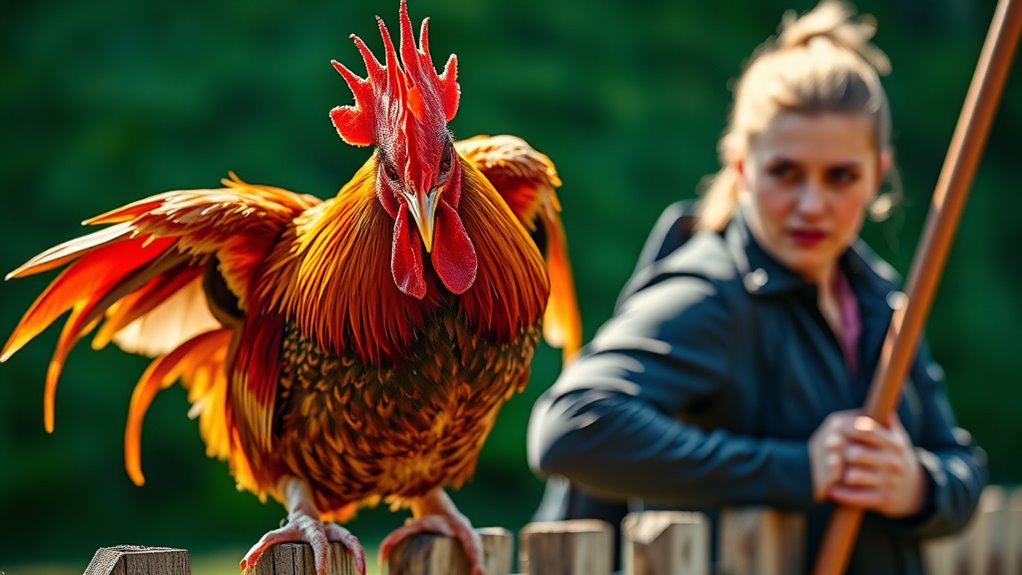
When dealing with roosters, it's essential to recognize their body language and sounds.
A lowered head or intense staring can signal that a rooster is ready to attack, while foot stamping and raised hackles indicate agitation.
Body Language Indicators
Roosters communicate their feelings through distinct body language, and recognizing these signs of aggression can keep you safe.
A lowered head often signals that the rooster is preparing to attack, indicating potential aggression.
Watch for foot stamping; it serves as a warning signal, suggesting the rooster is agitated and may escalate if provoked.
Raised hackle feathers are another clear indication that the rooster feels threatened or is ready to defend its territory.
Intensive staring and mock charges show the rooster is asserting dominance and preparing for confrontation.
By understanding these aggressive behaviors, you can better manage your interactions and guarantee your safety around these spirited birds.
Stay observant to protect yourself effectively.
Vocalizations and Sounds
Vocalizations play an essential role in a rooster's expression of aggression, as they assert dominance and communicate territorial claims to both hens and other roosters.
You might notice loud crowing or aggressive clucking when a rooster feels threatened or wants to establish hierarchy. A low, threatening growl or sharp staccato clucks can signal that your rooster is preparing to attack.
Additionally, rapid, high-pitched calls often indicate heightened aggression, warning the flock of potential threats. These vocalizations can serve as a precursor to physical aggression, so it's vital to pay attention to changes in your rooster's vocal patterns.
Aggressive Posture Signs
Aggressive postures in roosters are vital signals that indicate their readiness to assert dominance or defend their territory.
An aggressive rooster often lowers its head while hopping or dancing, suggesting it's preparing to attack. Foot stamping serves as a warning signal, reflecting agitation and a desire to establish its place in the pecking order. Raised hackle feathers indicate a threatened bird gearing up for an aggressive display.
Additionally, intensive staring combined with mock charges should never be ignored, as they often precede aggression in roosters. Flapping wings, even without cause, can signal aggressive intent, making the rooster appear larger and more intimidating.
Recognizing these signs is vital for your safety and the well-being of your flock.
Techniques for Managing Aggression
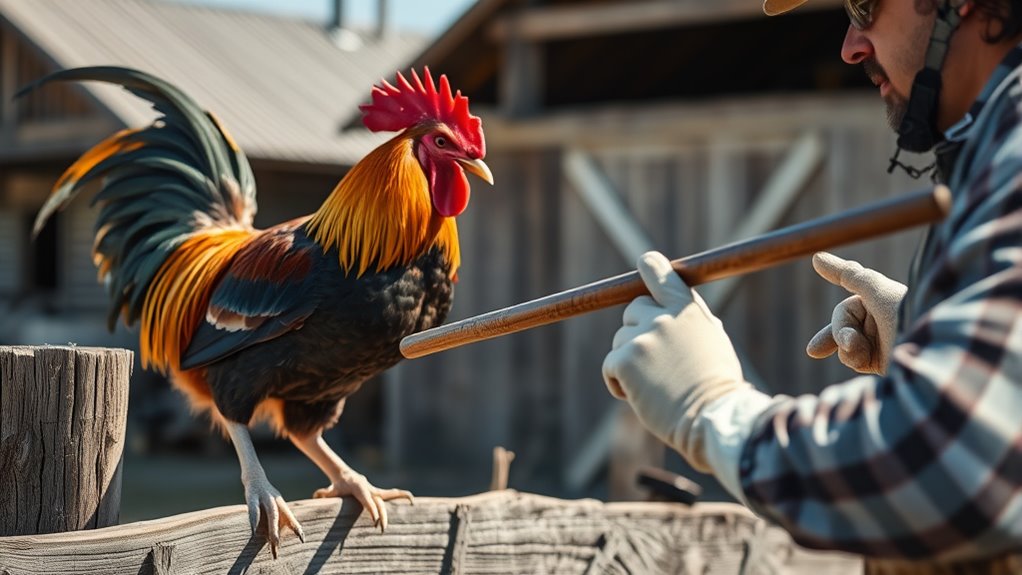
When dealing with an aggressive rooster, it's essential to establish dominance effectively to manage their behavior. Use arm movements to appear larger and more intimidating, which can deter aggressive actions.
Consider implementing a "time out" cage for aggressive roosters; this allows them to calm down and reduces their aggressive tendencies. Gradually introduce new chickens to your flock to minimize territorial aggression and avoid provoking stress.
Consistent routines in handling and interacting with your roosters help assert your dominance and prevent aggression from escalating. Additionally, utilize positive reinforcement techniques, such as offering treats, to encourage calm behavior and build trust.
Catching an Aggressive Rooster

Catching an aggressive rooster can be challenging, but timing and technique make a big difference. Wait until sundown when the chickens are calm and roosted. This is the best time for catching an aggressive rooster, as they're less likely to react.
Remember to wear protective clothing, like gloves and long sleeves, to minimize injury risks. Use a flashlight to locate the rooster, and approach slowly to avoid startling it.
Once you're close, secure both wings and legs. Hold the rooster firmly to prevent flapping, then transfer it to a safe cage or pen.
To build confidence and reduce stress during handling, practice regularly. With patience, you'll improve your skills and interactions with the rooster.
Protecting Yourself From Rooster Attacks
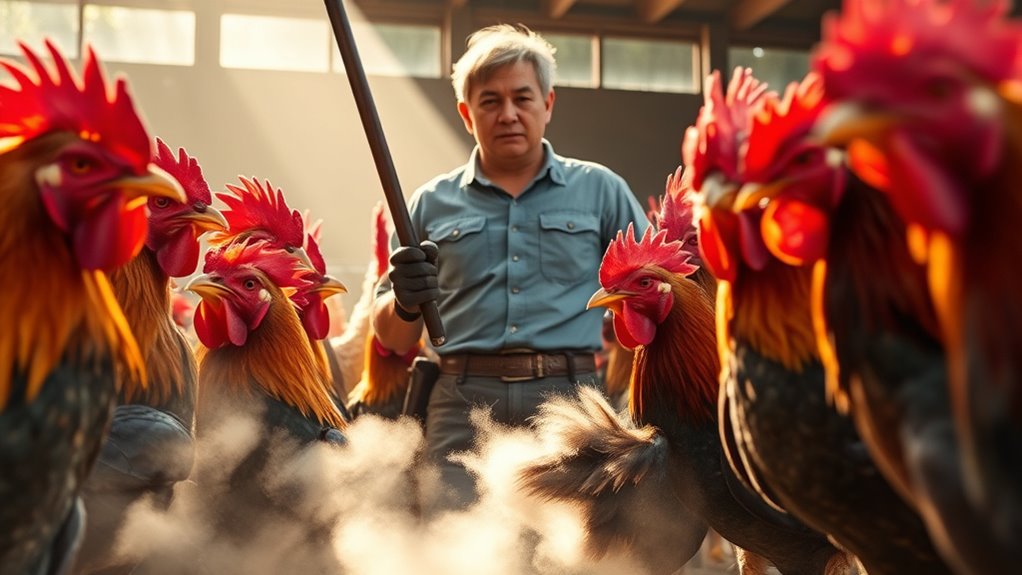
How can you protect yourself from rooster attacks?
Start by wearing protective clothing like knee-high rubber boots, thick jeans, and gloves to shield against potential injuries from an aggressive rooster.
Stay alert and monitor behavior closely, watching for signs of aggression. If you encounter a confrontational rooster, assert your dominance by standing your ground.
Maintain eye contact and move slowly to avoid escalating the situation. Remember, roosters can sense fear, so keep a confident posture.
Additionally, use distractions like food or toys to redirect the rooster's attention away from you, reducing the chance of an attack.
Stopping an Attack Before It Happens
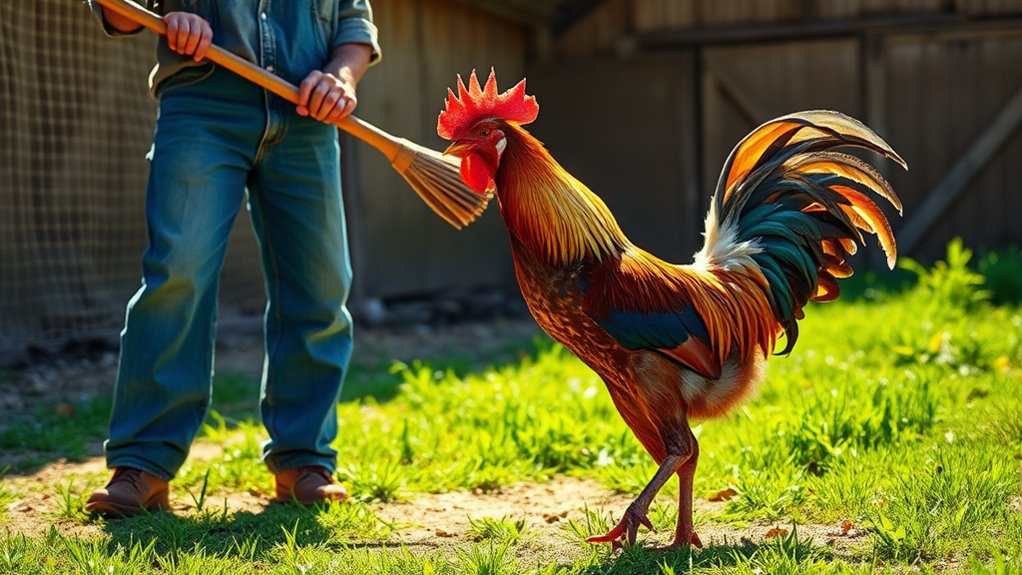
To stop an attack before it happens, you need to recognize warning signs like a lowered head or foot stamping.
Establishing dominance techniques can help you project confidence, which often deters aggressive behavior.
Recognizing Warning Signs
Recognizing the warning signs of an aggressive rooster can help you avoid an attack before it happens. Pay attention to a lowered head and intense staring; these often signal that the rooster is gearing up to assert dominance.
Foot stamping is another vital warning sign—this indicates agitation and a potential charge if you provoke it further. If you notice raised hackle feathers, that's a clear indication of aggression and a readiness to attack.
Be wary of mock charges, where the rooster runs toward you without full commitment, as these can precede a serious attack. By closely observing the rooster's body language, you can anticipate aggressive behavior, allowing you to take proactive measures to de-escalate potential conflicts.
Establishing Dominance Techniques
Understanding the warning signs of aggression is just the first step; knowing how to establish dominance can prevent an attack before it happens.
Start by maintaining a calm demeanor and avoiding sudden movements around the aggressive rooster, as this reduces perceived threats. Use body language to assert your position—stand tall and make yourself appear larger to deter aggression.
If the rooster approaches, step toward it while maintaining eye contact to reinforce your dominance. Implement a consistent routine for feeding and handling to reinforce your leadership role, minimizing challenges to your authority.
Additionally, consider using distractions like food or toys to redirect the rooster's focus from aggression to more positive interactions.
Making the Decision to Rehome a Rooster

When an aggressive rooster threatens the safety of your flock or those around you, deciding to rehome him becomes essential.
If his aggression persists despite your management efforts, it might indicate he can't adapt to your flock's dynamics.
Rehoming should be a last resort, following attempts to manage his behavior, like introducing another rooster or adjusting the flock's composition.
When you do decide to rehome, seek a safe environment where he can thrive, preferably with experienced owners who understand aggressive behaviors.
This guarantees not only his well-being but also reduces the risk of aggression towards new caretakers.
Prioritize the safety of your flock and community while considering the best future for your rooster.
Frequently Asked Questions
How to Handle an Aggressive Rooster?
When handling an aggressive rooster, start by wearing protective clothing to shield yourself.
Stand your ground confidently; running away might encourage the rooster's aggression.
Approach during roosting times when the bird is calmer, and pick it up carefully, securing its wings and legs.
Use treats to promote positive behavior, building trust over time.
If aggression continues, consider a brief separation to recalibrate its behavior and reassess its interactions with the flock.
How Do You Assert Dominance Over a Rooster?
To assert dominance over a rooster, you need to project confidence. Stand tall, maintain direct eye contact, and use arm movements to appear larger.
When the rooster approaches aggressively, calmly step towards it, showing that you won't back down. Regularly pick it up during calm moments to reinforce your role as the leader.
Establish consistent routines and boundaries, correcting aggressive behaviors while rewarding calm actions to strengthen your position over time.
How to Mellow Out a Rooster?
So, you've got a feathered little tyrant ruling your backyard, huh?
To mellow out your rooster, start by handling him regularly during calm moments. Use treats as bribes—err, I mean, positive reinforcement. Keep your posture confident; you're the boss here!
Create a fun environment with toys to keep him busy, and consider introducing a new rooster. It's like a feathered reality show, and everyone loves a good plot twist!
How to Get Rid of Unwanted Roosters?
If you're looking to get rid of unwanted roosters, start by rehoming them to local farms or poultry enthusiasts.
You can advertise on social media or local classifieds, which often leads to quicker placements.
Contact animal shelters or rescue organizations that focus on poultry; they may help find suitable homes.
You might also join online chicken-keeping forums where members could be interested in adopting.
As a last resort, consult a vet about humane euthanasia.
Conclusion
In the end, handling aggressive roosters takes patience and a bit of know-how. Picture yourself stepping into the coop, armed with understanding and techniques to manage their behavior. You spot a rooster puffing up, ready to charge, but your calm presence defuses the situation. With practice, you'll find yourself not only safe but also developing a respectful bond with your flock. Sometimes, it's in these unexpected moments that you discover the joy of chicken keeping.

